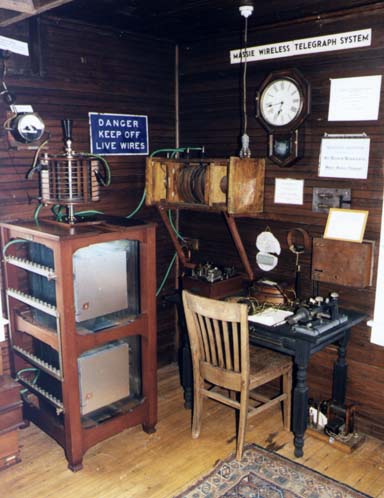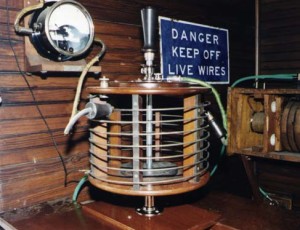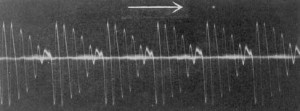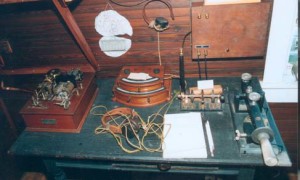 The Massie Station is listed in the National Register of Historic Places and the Massie Wireless Club operates an amateur radio operation from the station using the club call sign N1EPJ.
The Massie Station is listed in the National Register of Historic Places and the Massie Wireless Club operates an amateur radio operation from the station using the club call sign N1EPJ.
The photo shows the Massie spark transmitter under restoration. All of the original equipment is in the station except the change-over switch, which was assembled by Alan Douglas from original parts. The pump handle key, Massie Resonaphone tuner and operator call box are on the original table.
The helix and straight spark gap are on top of the condenser cabinet. On the left wall above the helix are a hot wire ammeter and anchor gap.
Bert Pine donated 100 sheets of 18″ square 1/8″ glass and Michael Thompson has made 70 of the 100 glass plate condensers that fit in the cabinet below the spark-gap and helix. Rolf Richter cast new zinc spark gap electrodes, machined new electrode holders, and even had the machined parts nickel plated. The original high-voltage cables had bright green woven cloth insulation.
Dave and Judi Kernan made a covering for the new high-voltage cables that closely matches the appearance of the originals. We used a Marconi 2 KW spark coil because we don’t have a Massie coil or information on the design of a Massie coil. We made a key relay using a Massie wooden parts box to make the pump-handle key safer to use during demonstrations. The transmitter now makes big sizzling sparks! We will not connect an antenna to the transmitter so we can keep the FCC happy. This is one of the oldest working wireless transmitter in the world.
We currently have about 0.05 mF of capacitance so the transmitter operates at about 350 KHz. It will operate at about 300 KHz when the remainder of the condenser plates are installed.
Hear what it would sound like. (Sound file courtesy of John S. Belrose.)
 This is a close-up of the helix with a straight spark gap inside and the hot wire ammeter on the wall. Rolph Richter cast the zinc spark gap electrodes and machined the new electrode holders.
This is a close-up of the helix with a straight spark gap inside and the hot wire ammeter on the wall. Rolph Richter cast the zinc spark gap electrodes and machined the new electrode holders.
The theory behind the transmitter is simple. The high-voltage coil and capacitor are connected in parallel. The helix coil and spark gap are connected in series and the pair are connected in parallel with the capacitor. The high-voltage coil charges the capacitor. When the voltage on the capacitor reaches the breakdown voltage of the air between the spark electrodes the spark jumps between the electrodes.  This makes a L-C circuit that oscillates at 350 KHz. Since some of the energy is lost in the spark the amplitude of the sine wave in the L-C circuit diminishes. This is called a damped oscillation and is shown in the oscillograph image to the right. Since the high-voltage coil is driven by AC, one 1/120 of a second later the circuit is charged and sparking again.
This makes a L-C circuit that oscillates at 350 KHz. Since some of the energy is lost in the spark the amplitude of the sine wave in the L-C circuit diminishes. This is called a damped oscillation and is shown in the oscillograph image to the right. Since the high-voltage coil is driven by AC, one 1/120 of a second later the circuit is charged and sparking again.
 From left to right are shown the operator call box, Resonaphone receiver, change-over switch, and the pump handle key. The box on the wall contains the key relay.
From left to right are shown the operator call box, Resonaphone receiver, change-over switch, and the pump handle key. The box on the wall contains the key relay.
The receiver will hear the repetition rate of the sparks.